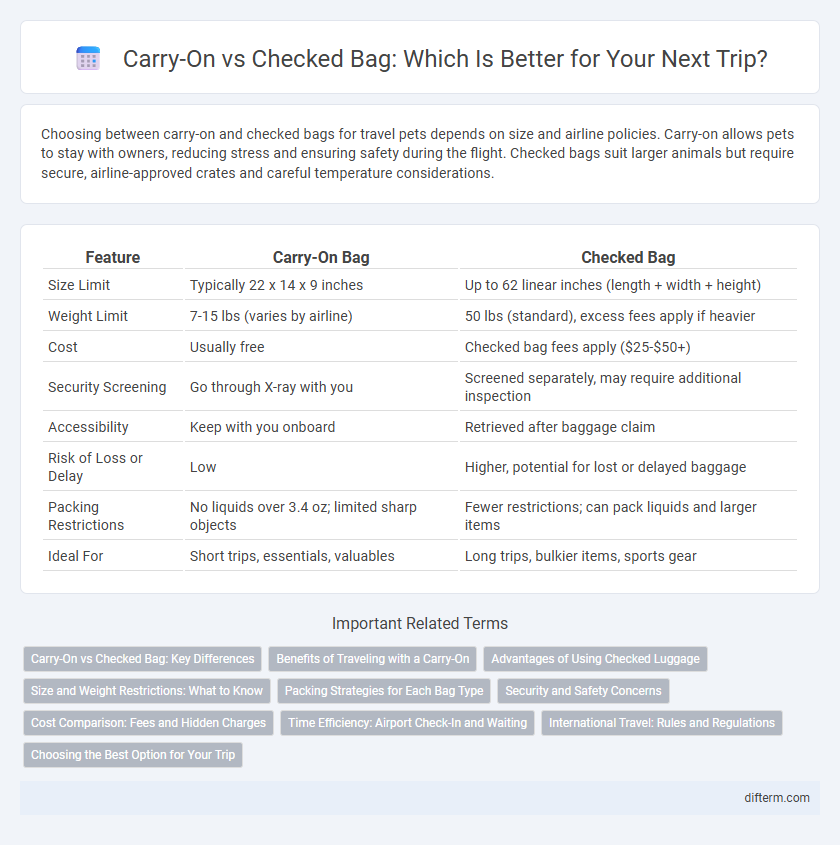Choosing between carry-on and checked bags for travel pets depends on size and airline policies. Carry-on allows pets to stay with owners, reducing stress and ensuring safety during the flight. Checked bags suit larger animals but require secure, airline-approved crates and careful temperature considerations.
Table of Comparison
| Feature | Carry-On Bag | Checked Bag |
|---|---|---|
| Size Limit | Typically 22 x 14 x 9 inches | Up to 62 linear inches (length + width + height) |
| Weight Limit | 7-15 lbs (varies by airline) | 50 lbs (standard), excess fees apply if heavier |
| Cost | Usually free | Checked bag fees apply ($25-$50+) |
| Security Screening | Go through X-ray with you | Screened separately, may require additional inspection |
| Accessibility | Keep with you onboard | Retrieved after baggage claim |
| Risk of Loss or Delay | Low | Higher, potential for lost or delayed baggage |
| Packing Restrictions | No liquids over 3.4 oz; limited sharp objects | Fewer restrictions; can pack liquids and larger items |
| Ideal For | Short trips, essentials, valuables | Long trips, bulkier items, sports gear |
Carry-On vs Checked Bag: Key Differences
Carry-on bags offer convenience by allowing travelers to avoid baggage claim and save time during airport security checks, typically restricted to dimensions around 22 x 14 x 9 inches. Checked bags provide greater packing capacity, usually allowing up to 50 pounds or more, but require longer wait times and can incur additional fees depending on the airline. Choosing between carry-on and checked luggage depends on trip duration, airline policies, and personal preferences for ease and packing volume.
Benefits of Traveling with a Carry-On
Traveling with a carry-on bag streamlines airport navigation by eliminating the need to wait at baggage claim, saving valuable time and reducing stress. Carry-ons reduce the risk of lost luggage, ensuring essential items remain accessible throughout the trip. Airlines often charge extra for checked bags, making carry-ons a cost-effective option that also encourages lighter, more efficient packing.
Advantages of Using Checked Luggage
Checked luggage offers travelers the advantage of carrying larger and heavier items without the hassle of airport carry-on size restrictions. It provides convenience by freeing up personal space in the cabin, allowing passengers to move more comfortably and avoid overhead bin struggles. Airlines often allow checked bags with an average weight limit of 50 pounds, enabling longer trips and the inclusion of bulky essentials such as sports equipment or extra clothing.
Size and Weight Restrictions: What to Know
Carry-on bags typically have size restrictions around 22 x 14 x 9 inches and weight limits ranging from 15 to 22 pounds depending on the airline. Checked bags usually allow larger dimensions, often up to 62 linear inches combined (length + width + height) and weight limits between 50 to 70 pounds. Exceeding these size and weight restrictions usually results in additional fees or the requirement to recheck or adjust luggage prior to boarding.
Packing Strategies for Each Bag Type
Efficient packing strategies involve maximizing space in carry-on bags by prioritizing essential items, versatile clothing, and travel-sized toiletries to adhere to airline size limits and security regulations. Checked bags can accommodate bulky items, shoes, and non-essential extras, allowing travelers to distribute weight evenly and reduce carry-on load. Strategic packing includes rolling clothes to minimize wrinkles, using packing cubes for organization, and placing heavy items at the bottom of checked luggage to prevent damage.
Security and Safety Concerns
Carry-on bags enhance security by allowing travelers to keep valuables and important documents within reach, reducing the risk of theft or loss. Checked bags pose potential safety concerns due to possible mishandling, damage, or exposure to prohibited items during airport screening. TSA regulations and thorough screening processes aim to mitigate these risks, but remaining vigilant with carry-on items ensures greater personal control and protection.
Cost Comparison: Fees and Hidden Charges
Carry-on bags often save travelers money by avoiding checked baggage fees that can range from $30 to $60 per flight, depending on the airline and route. Checked bags may incur hidden charges such as overweight fees, which can add $50 or more, and fees for early check-in or oversized luggage. Choosing carry-on luggage minimizes unexpected expenses while streamlining the travel experience, especially for budget-conscious passengers.
Time Efficiency: Airport Check-In and Waiting
Carry-on bags streamline airport check-in by eliminating the need to wait at baggage drop counters, significantly reducing overall waiting time. Travelers bypass the risk of delayed baggage claim and proceed directly through security to their gate, enhancing time efficiency. This advantage is especially critical for short trips or tight layovers where time management is essential.
International Travel: Rules and Regulations
International travel regulations mandate strict adherence to carry-on and checked bag size limits, typically allowing carry-ons up to 22 x 14 x 9 inches and checked bags up to 62 linear inches with weight restrictions around 50 pounds. Security rules enforced by agencies like the TSA and equivalent international bodies restrict liquids in carry-ons to 3.4 ounces per container in a quart-sized bag, while prohibited items vary by country. Airlines may charge extra fees for checked baggage on international flights, making it crucial to review specific airline policies and customs regulations before packing.
Choosing the Best Option for Your Trip
Selecting between a carry-on and a checked bag depends on trip length, airline baggage policies, and personal convenience. Carry-ons offer faster airport navigation and reduced risk of lost luggage, ideal for short trips and quick connections. Checked bags provide more packing space, suitable for extended travel or when carrying larger items like liquids, sports gear, or souvenirs.
carry-on vs checked bag Infographic

 difterm.com
difterm.com